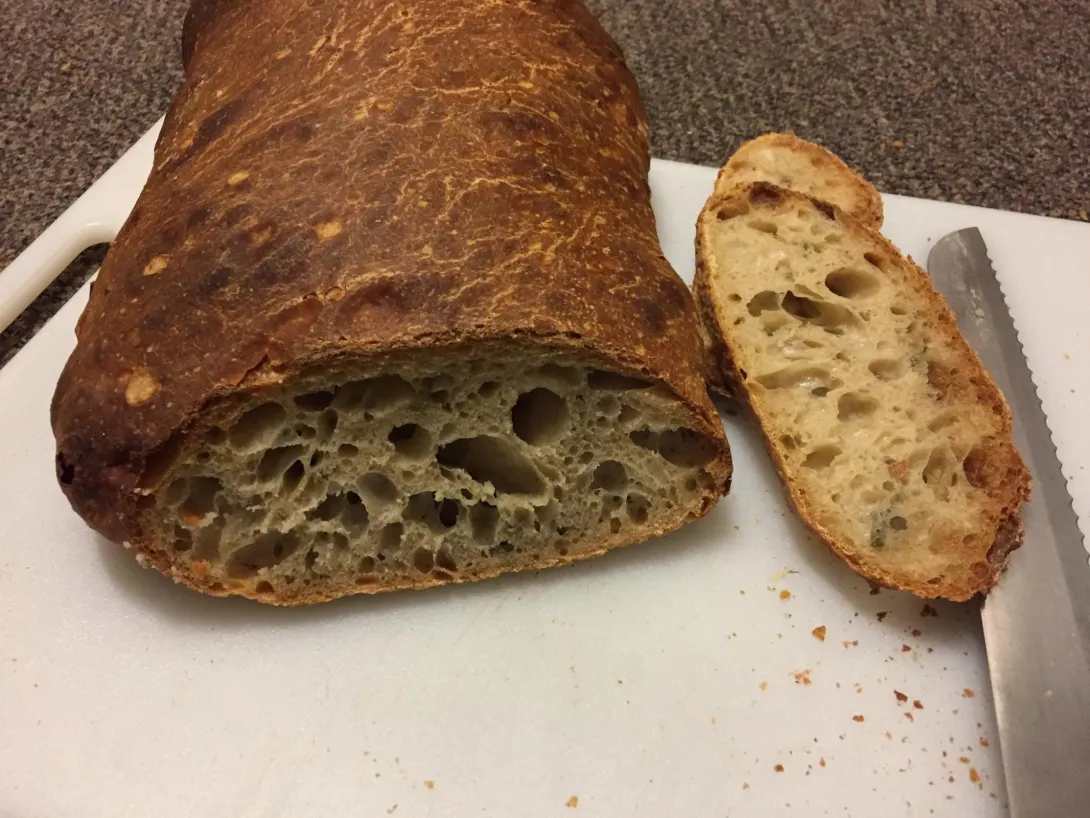
Hi everybody,
This weekend, I made one of my favorite breads — sourdough rosemary ciabatta. Although the dough is a bit painful to work with because of it’s hydration, I enjoy it because it feels really alive. The finished loaf tastes great — especially when eaten with butter while still warm. I also love the degree of oven spring you get — it always seems to me like these loaves expand a crazy amount in the oven.
Unlike most bread I make, this is an enriched dough — it has both oil and milk. I really like the crumb, flavor, and crust color that comes from this.
For today’s batch, I encountered a difficulty. I didn’t have enough KA AP flour, so I had to run to the store. They were out, so I had to use a pretty large porportion of Gold Medal unbleached AP instead. Knowing that this flour has less protein than KA, I withheld about 20 grams of water. Unfortunately, I accidentally added 50 grams more milk than I wanted to, so the dough still ended up really wet and hard to handle. Admittedly, the loaves were underproofed because I was busy and wanted to get them out of the oven by a certain time, and the kitchen was chilly (I don’t have control over the temperature in my dorm kitchen). Despite these issues, the bread came out great.
I didn’t quite get as much loft as I’d’ve liked, but the crumb had a really nice texture and flavor. This isn’t the best example of this recipe, but it works. I originally got this recipie from my dad. I forget where he got it from, but he did do a bunch of visits to artisan bakeries and took a bunch of classes. I’ve tweaked it a bit, but not much (like using no bread flour and upping the oil).
The formula is as follows. The percentages do not take into account the water and flour in the starter and levain.
Levain:
All Purpose Flour — 38% — 57 grams
Whole Wheat Flour — 62% — 93 grams
Water — 117% — 176 grams
60% Hydration Starter — 25% — 38 grams
Final Dough:
All Purpose Flour — 100% — 1148 grams
Water — 72% — 828 grams
Whole Milk — 8.9% — 103 grams
Olive Oil — 3.5% — 40 grams
Fresh Rosemary — 1.5%-3.5% — 17 grams - 40 grams (to taste — I’ve tested it throughout this range, and prefer around 2%, but it’s good anywhere in here)
Salt — 2.4% — 28 grams
Levain — 32% — 364 grams
I prepare the levain the night before, and let it ferment 12 to 16 hours. In the morning, I mix the levain, flour, and water. Its pretty easy to get it all incorporated and get some degree of gluten development. You don’t want to develop it too much, but you should develop the gluten some. I put it back into a bowl and add the milk, oil, and salt. I mix in the bowl and incorporate these ingredients. It takes a bit, but once they are thoroughly mixed, I do a stretch and fold cycle. I then incorporate the finely chopped rosemary, and use folds to distribute it throughout the dough.
During bulk, I turn it every 30 minutes until it doesn‘t immediately become a puddle when dumped out. This usually takes 5 or 6 cycles of stretch and folds. It’s messy and sticks to everything, so it takes a bit to get used to it.
At the end of bulk, the dough should be full of air and pretty jiggly. If you gently hit the bowl, the dough shakes almost like jello. The hard part about shaping this dough is it’s too wet to move. So, you have to divide, shape, and proof on the parchment itll be baked on.
At this point, I lay out parchment paper and flour it lightly. I pour out the dough, lightly flour the top, and divide it into two roughly equal sections. I split them using quick, rapid movements with the bench scraper, being careful not to rip the parchment. I use a wet dough scraper to go around the edges of each puddle and tuck them under the loaf. This is kind of hard to describe. There will be a light skin on top from the flour, and you effectively pull this over the edges with the dough scraper. You push the dough under itself and quickly pull away the scraper.
After forming the loaves into ciabatta shapes, I split the parchment and cover them with a moist towel to proof. When they are getting close to being done, I preheat the oven and my baking stone to 450°F. Once the proof finishes, I go back around the dough with the scraper to tighten the shape a bit. I then gently dimple the loaf by pressing my fingers into the top lightly. The parchment goes onto the peel and into the oven.
I bake 20 minutes with steam at 450°, then I vent the oven and reduce the temperature to 405° to keep the crust from burning. It takes quite a while to bake out all the moisture, so be patient. Once they are done, I peel the parchment off the bottom and let them cool (but they are best eaten when still slightly warm from the oven in my opinion).
Sorry for the poor picture — being a ciabatta, I cut it on a slant to get more surface area and the lighting wasn’t all that good. The crumb came out wonderfully glossy and tender and translucent in parts.